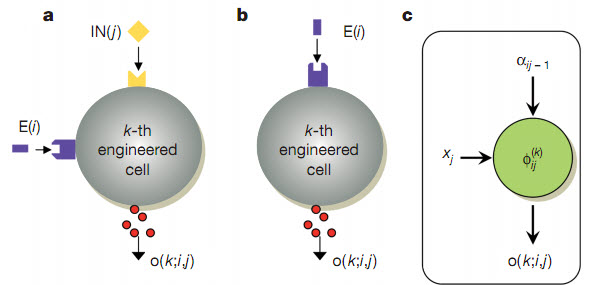Distributed biological computation imitates logic-gate circuits
December 15, 2010

Cells can receive signals (a) from other cells (IN) and external sources (E), or just from external sources (b). Cells can also produce diffusive output molecules. (Nature)
Genetically modified yeast cells can be made to communicate with each other as if they were electronic logic circuits, researchers at the University of Gothenburg, Sweden have found.
“Even though engineered cells can’t do the same job as a real computer, our study paves the way for building complex constructions from these cells,” says Kentaro Furukawa at the University of Gothenburg’s Department of Cell- and Molecular Biology, one of the researchers behind the study.
“In the future we expect that it will be possible to use similar cell-to-cell communication systems in the human body to detect changes in the state of health, to help fight illness at an early stage, or to act as biosensors to detect pollutants in connection with our ability to break down toxic substances in the environment.”
Using a library of genetically modified yeast cells, the research team at the University of Gothenburg has produced synthetic circuits based on gene-regulated communication between cells. The yeast cells sense their surroundings and send signals to other yeast cells by secreting molecules. The various types of cells can be combined like Lego bricks to produce more complex circuits, such as a multiplexer or a 1-bit adder with carry. The basic two-input and one-output engineered functions include AND and inverted IMPLIES, which allow for implementing any Boolean function. Using a construction of yeast cells with different genetic modifications, it is possible to carry out more complex computational functions.
Ref.: Distributed biological computation with multicellular engineered networks, Nature, Dec. 8, 2010
Adapted from materials provided by the University of Gothenburg